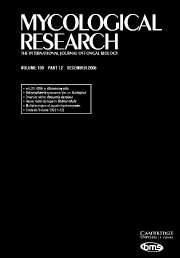Crossref Citations
This article has been cited by the following publications. This list is generated based on data provided by
Crossref.
2001.
Pathogenic and Ecological Roles of Fungal Melanins.
Mycological Research,
Vol. 105,
Issue. 6,
p.
643.
Kis-Papo, Tamar
Kirzhner, Valery
Wasser, Solomon P.
and
Nevo, Eviatar
2003.
Evolution of genomic diversity and sex at extreme environments: Fungal life under hypersaline Dead Sea stress.
Proceedings of the National Academy of Sciences,
Vol. 100,
Issue. 25,
p.
14970.
2003.
Fungi in Ecosystem Processes.
Nosanchuk, Joshua D.
and
Casadevall, Arturo
2003.
The contribution of melanin to microbial pathogenesis.
Cellular Microbiology,
Vol. 5,
Issue. 4,
p.
203.
2003.
Fungi in Ecosystem Processes.
2003.
Fungi in Ecosystem Processes.
Aslanidi, K. B.
Ivanova, A. E.
Blazheevskaya, Yu. V.
Zhdanova, N. N.
and
Belozerskaya, T. A.
2003.
Resistance of Microscopic Fungi to Oxidative Stress.
Doklady Biochemistry and Biophysics,
Vol. 392,
Issue. 1-6,
p.
241.
Burford, E. P.
Fomina, M.
and
Gadd, G. M.
2003.
Fungal involvement in bioweathering and biotransformation of rocks and minerals.
Mineralogical Magazine,
Vol. 67,
Issue. 6,
p.
1127.
Mahmoud, Yehia A. G.
2004.
Uptake of Radionuclides by Some Fungi.
Mycobiology,
Vol. 32,
Issue. 3,
p.
110.
Onofri, S.
Selbmann, L.
Zucconi, L.
and
Pagano, S.
2004.
Antarctic microfungi as models for exobiology.
Planetary and Space Science,
Vol. 52,
Issue. 1-3,
p.
229.
Purvis, O. William
Bailey, Elizabeth H.
McLean, Judith
Kasama, Takeshi
and
Williamson, Ben J.
2004.
Uranium Biosorption by the LichenTrapelia involutaat a Uranium Mine.
Geomicrobiology Journal,
Vol. 21,
Issue. 3,
p.
159.
Zhdanova, Nelli N.
Tugay, Tatyana
Dighton, John
Zheltonozhsky, Victor
and
Mcdermott, Patrick
2004.
Ionizing radiation attracts soil fungi.
Mycological Research,
Vol. 108,
Issue. 9,
p.
1089.
Grishkan, Isabella
Nevo, Eviatar
and
Wasser, Solomon P
2004.
Micromycetes from the Saline Arubotaim Cave: Mount Sedom, The Dead Sea Southwestern Shore, Israel.
Journal of Arid Environments,
Vol. 57,
Issue. 4,
p.
431.
Haase, Gerhard
and
Brakhage, Axel A.
2004.
Human Fungal Pathogens.
p.
67.
Ivanova, A. E.
Aslanidi, K. B.
Karpenko, Yu. V.
and
Belozerskaya, T. A.
2005.
The Effect of Hydrogen Peroxide on the Growth of Microscopic Mycelial Fungi Isolated from Habitats with Different Levels of Radioactive Contamination.
Microbiology,
Vol. 74,
Issue. 6,
p.
655.
Haselwandter, Kurt
Zakharchenko, Valentina
and
Zhdanova, Nelli
2005.
The Fungal Community.
Vol. 20050554,
Issue. ,
p.
759.
Conceição, D.M.
Angelis, D.A. de
Bidoia, E.D.
and
Angelis, D. de F. de
2005.
FUNGOS FILAMENTOSOS ISOLADOS DO RIO ATIBAIA, SP E REFINARIA DE PETRÓLEO BIODEGRADADORES DE COMPOSTOS FENÓLICOS.
Arquivos do Instituto Biológico,
Vol. 72,
Issue. 1,
p.
99.
Nieves‐Rivera, Á. M.
Rodríguez, N. J.
Dugan, F. M.
Zaidi, B. R.
and
Williams, E. H.
2006.
Modern Multidisciplinary Applied Microbiology.
p.
483.
Karpenko, Y. V.
Redchitz, T. I.
Zheltonozhsky, V. A.
Dighton, J.
and
Zhdanova, N. N.
2006.
Comparative responses of microscopic fungi to ionizing radiation and light.
Folia Microbiologica,
Vol. 51,
Issue. 1,
Grishkan, Isabella
Zaady, Eli
and
Nevo, Eviatar
2006.
Soil crust microfungi along a southward rainfall gradient in desert ecosystems.
European Journal of Soil Biology,
Vol. 42,
Issue. 1,
p.
33.

